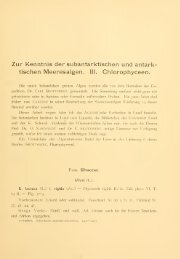Download PDF
Download PDF
Download PDF
You also want an ePaper? Increase the reach of your titles
YUMPU automatically turns print PDFs into web optimized ePapers that Google loves.
CHAPTER RIGHT<br />
THE GENUS DEBARYA WITTROCK 1872<br />
Wittrock established the genus Debarya better to classify the<br />
Mougeotia glyptosperma, so lucidly described and figured by<br />
Anton de Bary in 1858. Since then several other species have been<br />
discovered w^ith similar characteristics. The filaments are simple,<br />
made up of cells two to twenty diameters long with ribbonlike, or<br />
platelike, chromatophores with several distinct pyrenoids arranged<br />
either in a single row, or scattered. The nucleus is centrally<br />
located in the cell and attached to the side of the chromatophore.<br />
The Debaryas resemble the Mougeotias during the vegetative<br />
phase.<br />
They differ from the Mougeotias, however, during the repro-<br />
ductive phase. At the beginning of conjugation, or during aplan-<br />
ospore formation, the reproductive cells become filled with a cel-<br />
lulose colloid deposited as successive layers inside the cell walls.<br />
Moreover, there are no cytoplasmic residues left in the gametangia<br />
outside the spore walls. Conjugation is scalariform, and the gametes<br />
unite in the conjugating tubes (isogamous). Aplanospores,<br />
parthenospores, and akinetes have been observed in 2 of the<br />
species.<br />
The zygospores are compressed-spheroid, ovoid, or quadran-<br />
gular-ovoid. The spores of 4 of the species are distinctly tricari-<br />
nate, with an equatorial and two lateral keels. The median walls<br />
may be further ornamented with pits, radial ridges, and undu-<br />
lations.<br />
All the 6 species are exceedingly rare, but they have been col-<br />
lected in Europe, Asia, North America, and New Zealand; they<br />
are probably more widely distributed than is surmised at the<br />
present time.<br />
Several of the species that were formerly described as belong-<br />
ing to this genus have now been placed in the genera : Mougeotia,<br />
Mougeotiopsis, Zygnemopsis, and Hallasia.<br />
75




